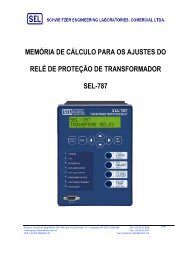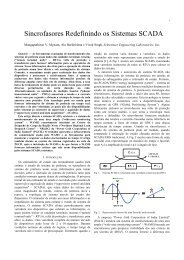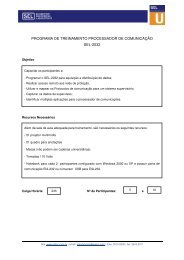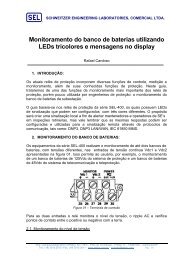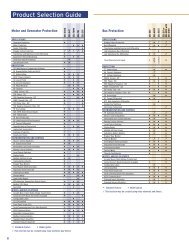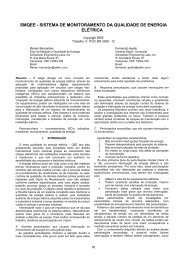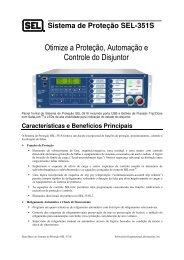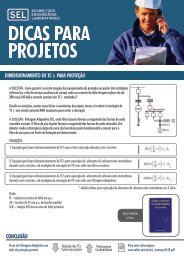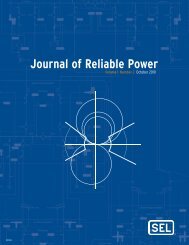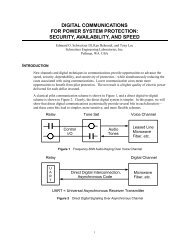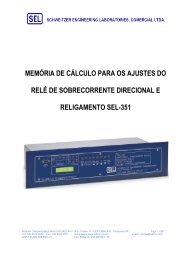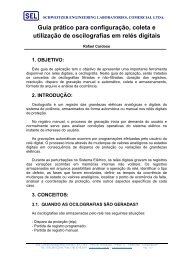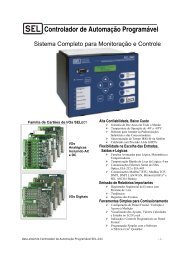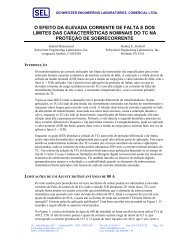Journal of Reliable Power - SEL
Journal of Reliable Power - SEL
Journal of Reliable Power - SEL
Create successful ePaper yourself
Turn your PDF publications into a flip-book with our unique Google optimized e-Paper software.
15<br />
B. Adaptive Resistance Element<br />
Fig. 29 shows the quadrilateral distance element<br />
characteristic that uses the adaptive reactance element <strong>of</strong> the<br />
previous design with an adaptive resistive element.<br />
X<br />
Adaptive Reactance Element<br />
setting <strong>of</strong> 11.52 ohms and an impedance reach (Zset) setting <strong>of</strong><br />
120 percent <strong>of</strong> ZL1. The mho distance element has a reach <strong>of</strong><br />
120 percent <strong>of</strong> ZL1. The sensitivity <strong>of</strong> all the distance<br />
elements is 0.05 • Inom.<br />
Fig. 30, Fig. 31, and Fig. 32 show the Rf coverage <strong>of</strong> mho<br />
and quadrilateral distance elements. We observe that the Rf<br />
coverage is severely reduced as the fault approaches the end <strong>of</strong><br />
the line. As expected, the mho element is the one with less Rf<br />
coverage, and the adaptive resistance element has the greatest<br />
Rf coverage, especially for power flow in the forward<br />
direction, δ equal to 10 degrees.<br />
20<br />
18<br />
Mho Distance Element<br />
Quadrilateral Distance Element<br />
Adaptive Resistive Element<br />
Z LINE<br />
Adaptive<br />
Resistive<br />
Element<br />
16<br />
14<br />
Rset = 11.52 ohms<br />
δ = -10 degrees<br />
R<br />
Fault Resistance (ohms)<br />
12<br />
10<br />
8<br />
6<br />
Fig. 29. Quadrilateral distance element characteristic with adaptive<br />
resistance element<br />
The adaptive resistive element calculates Rf according to<br />
(38) and (39), and compares the minimum <strong>of</strong> the two<br />
calculation results against the resistive setting.<br />
j⋅θ<br />
L1<br />
( )<br />
j⋅θ<br />
L1<br />
*<br />
( )<br />
Im<br />
⎡<br />
V • I2 • e<br />
⎢<br />
R2 =<br />
⎣<br />
Im<br />
⎡<br />
I • I2 • e<br />
⎢⎣<br />
Im<br />
⎡<br />
V • I<br />
⎢<br />
Rα<br />
=<br />
⎣<br />
Im<br />
⎡<br />
I • I<br />
⎢⎣<br />
⎤<br />
⎥⎦<br />
⎤<br />
⎥⎦<br />
*<br />
j⋅θ<br />
L1<br />
( α • e )<br />
j⋅θ<br />
L1<br />
*<br />
( α • e )<br />
⎤<br />
⎥⎦<br />
⎤<br />
⎥⎦<br />
*<br />
(38)<br />
(39)<br />
Equation (38) is equivalent to (11) and (12). It uses a<br />
different form <strong>of</strong> phase comparator equation. Equation (39)<br />
uses the alpha component (Iα = I1 + I2).<br />
C. Resistive Coverage<br />
To compare the resistive coverage <strong>of</strong> the traditional<br />
distance elements with the adaptive resistive element, we use<br />
the system in Fig. 4 and perform the tests discussed in the<br />
following sections.<br />
1) Faults at Multiple Locations<br />
We calculate the maximum Rf that the distance elements<br />
can detect for an A-phase-to-ground fault for m values from 0<br />
to 1 and load angles <strong>of</strong> δ equal to –10, 0, and 10 degrees. The<br />
quadrilateral distance elements have a resistive reach (Rset)<br />
4<br />
2<br />
0<br />
0 0.1 0.2 0.3 0.4 0.5 0.6 0.7 0.8 0.9 1<br />
Fault Location (pu)<br />
Fig. 30. Rf coverage <strong>of</strong> mho and quadrilateral distance elements for<br />
δ equal to –10 degrees<br />
Fault Resistance (ohms)<br />
8<br />
7<br />
6<br />
5<br />
4<br />
3<br />
2<br />
1<br />
Mho Distance Element<br />
Quadrilateral Distance Element<br />
Adaptive Resistive Element<br />
Rset = 11.52 ohms<br />
δ = 0 degrees<br />
0<br />
0 0.1 0.2 0.3 0.4 0.5 0.6 0.7 0.8 0.9 1<br />
Fault Location (pu)<br />
Fig. 31. Rf coverage <strong>of</strong> mho and quadrilateral distance elements for δ equal<br />
to 0 degrees<br />
Adaptive Phase and Ground Quadrilateral Distance Elements | 79



